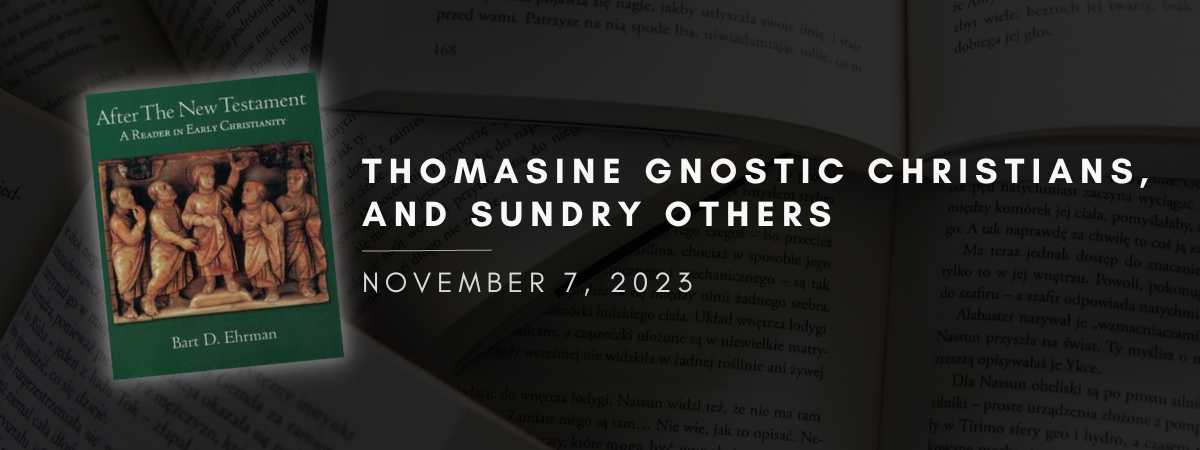In this thread of posts I have been reproducing my comments on Gnosticism from the 2nd edition of my anthology, After the New Testament. In addition to the Sethians and the Valentinians, scholars talk about the school of Thomas and about yet other Gnostic groups that are not easy to identify with any of the other three or to group together in any meaningful way. Gnosticism was a messy group of religions! Here is what I say in the Introductions to the Thomasines and the Other Gnostic groups in the book.
******************************
Thomasines
A number of books from the early Christian tradition are connected with a figure known as Didymus Judas Thomas. The word “Didymus” means “twin” in Greek; so too the name “Thomas” means “twin” in Aramaic. And so this person is Judas, or Jude, the twin. But the twin of whom? In our earliest surviving Gospel, Jesus himself is said to have a brother who is named Jude (for example, Mark 6). And in later traditions, especially from Syria, this Jude was thought to have been a twin of Jesus himself. In fact, in some traditions – including the Acts of Thomas that we have already seen (Chapter 2) – Thomas is Jesus’ identical twin. How Jesus could have a (mortal) twin if he was born of a virgin is something these traditions never explain.
There appears to have been a range of Christians who especially revered Didymus Judas Thomas. And who better to acclaim the truth among Jesus’ earthly associates than his own identical twin brother? Several of these books share important views and concerns, making it appear that these Thomasine Christians may have been their own Christian group, sharing key theological views and accepting various literary texts associated with Thomas.
Among these texts would be the Gospel of Thomas, given elsewhere here (see Selection 43), the Acts of Thomas, also given elsewhere (see Selection 48), a beautiful poem called the “Hymn of the Pearl,” embedded in these Acts of Thomas, and a book discovered among the Nag Hammadi Library called the Book of Thomas the Contender, or sometimes simply the Book of Thomas.
It is debated whether any or all of these books should be considered “Gnostic.” Many scholars today think that the answer is no, but it must be admitted that there is at least a Gnostic-like quality about these writings. They certainly do not narrate any of the complex Gnostic myths, as can be found among Sethian writings such as the Secret Book of John. If the narration of these myths is what makes a book Gnostic, then obviously the Thomasine literature does not qualify. On the other hand, these Thomasine writings do seem to presuppose a mythological understanding of the world which, without all the complexities of the developed Gnostic systems that we read elsewhere, has in broad outline many fundamental parallels with and similarities to the Gnostic myths.
These books, for example, understand that the real human is a being that has come from another realm into this world, and that it has been trapped here in the realm of matter. Being here, in the human body, is like being drunk or forgetful – out of touch with reality. The real person needs to escape this entrapment in the body, by becoming sober again, wakeful, and alert. This can happen when the person comes to the gnosis – the knowledge – of the truth, as revealed, for example, by Christ. And part of this salvation by gnosis comes through the practice of rigorous asceticism, the rejection of the pleasures of the flesh. These are all themes that would have resonated with Gnostic Christians, and so it may be that even if this Thomasine literature was not generated by Gnostics and for Gnostics, it would have easily been amenable to Gnostic understandings of the world. This may be why two of these Thomasine writings were included among the treatises of the Nag Hammadi library, most of which are more clearly Gnostic in their orientation.
Other Gnostic Texts
As we have seen, scholars over the past two decades have come to realize that Gnosticism was an inordinately complex and messy set of religious traditions and practices. In some ways it is very convenient, but completely misleading, to categorize all Gnostics as Sethians, Valentinians, and Thomasines. Just as Christianity itself has a mind-boggling range of variant groups supporting divergent beliefs and practices – yet all of them in some way or another cohering enough to warrant labeling them “Christian” – so too with Gnosticism.
Some of the texts discovered at Nag Hammadi library do not fit neatly into the narrow confines of Sethian, Valentinian, or Thomasine texts, yet they share many of the same concerns. In particular, there are texts that recount myths about the rise of the divine realm, the creation of the material world, and the beginning of the human race that do not contain many of the most salient features of the specifically Sethian myths. They may talk about divine Sophia or the creator God Ialdabaoth, for example, but they make no reference to the distinctively Sethian concept of the four luminaries: Harmozel, Oroiael, Daueithai, and Eleleth. And so these texts are not Sethian (and certainly not Valentinian or Thomasine), and yet they are very much aligned with Sethian understandings of the world and the human’s place in it.
These various texts do not cohere particularly well with one another either, so that they do not represent yet another Gnostic school of thought. And so it is perhaps better simply to say that they represent “Other Gnostic” views or that they are “Gnostic-like” in their concerns, views, and myths. Here we will see two such documents that can give a sense of what non-Sethian Gnostic myth can look like.
You must be logged in to post a comment.Share Bart’s Post on These Platforms
9 Comments
Leave A Comment









Was the doubting Thomas story directed at followers of Paul, as well as gnostics who didn’t believe in a corpse revival type of resurrection? The purpose being to convey it was not merely a spiritual body?
No, I don’t think it could have been. John was written before there were Gnostics around. But it could certainly have been directed against Christians (prior to Gnosticism) who maintained, in good Greek fashion, that the body does not live after death, only the spirit does.
Hi Dr. Ehrman, I have a off topic question. In the Gospel of Matthew Jesus gives the power to Bind and Loose to the Apostles and some scholars have pointed out by parallels to language in Jewish literature that the power to interpret legal matters by Rabbi’s was called Binding and Loosing. Others have found parallels between the ordination of Rabbis and Christian clergy by the laying of hands and apparently a belief that all Rabbis were appointed in a succession going al the way back to Moses. With this in mind what figures might the author of the Gospel of Matthew in their time of about 80 AD would have considered to hold this power of Binding and Loosing? Do you think the author of Matthew believed in something like Apostolic Succession? Some have argued that this passage of those with the powers to Bind and Loose reflects ideas and organizational structure that is ancestral to the historic ideas of Christian clergy and apostolic succession. Would you say that this is true? Would love to hear your thoughts on what those passages can tell us about the origins of clerical authority in Christianity.
It’s a great question, and I don’t know. Matthew does, of course, have an ecclesiology (see Matt 18 as well), but whether he had a concept of succession … so far as I can tell, he doesn’t give any hints. He does think the end is coming soon so he didn’t have the idea of a succession foer the long term.
Hi, Bart. Regarding the section about Jesus’s twin, Jude or Judas, were there any other gnostic or orthodox writings that dispelled this notion? As you mentioned, if Jesus had an identical twin, that would be difficult to to harmonize or explain away.
One more question. Are there any ancient writings that explore or claim Jesus wasn’t really resurrected, but it was in fact his twin his followers saw?
No and no! Too bad, that would make things even more interesting!
No doubt!
Thanks for answering, in general, what inferences can be had about the first few generations of clergy within Chritainity or what scholars or works I could look into on that. I’m particulary interested in the origin of the idea of Apostolic Succession and did the earliest Christians really believe that for someone to be a member of the clergy that had to be a part of a succession of appointments going all the way back to the Apostles and or Jesus. With Mt 18:18 it appears that there also is the idea that in some circumstances the decesions of these clergy are divinely guarented to be infalible With Mt 18:18 do you think that’s what the author of Matthew has in mind?
It’s a good question and I don’t know of a good answer — that is I don’t know of any handy book that deals with that. Maybe someone else on the blog can help us out? Already by Irenaeus and Tertullian you have explicit discussion of something like our “apostolic succession,” But even before that 1 Clement (95 CE or so) insists that duly appointed leaders are not to be deposed. Ignatius insists each church should have one bishop who is to be revered and obeyed like God. If you want to see some of the relevant early texts in translation you can look at chapter 12 in my book After the New Testament (excrpts from 1 Clement, Didache, Ignatius, Hipplytus, Didascalia and Cyrprian)